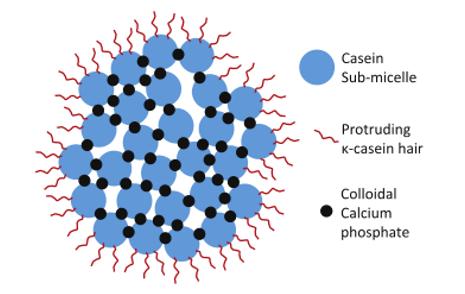Lifeasible specializes in milk protein detection and offers services to help detect casein and whey protein in milk and milk products.
There are two different types of milk proteins, casein and whey protein. The ratio of casein to whey proteins shows interspecies differences. The ratio is ~40:60 in human milk and ~80:20 in cow, goat, sheep, and buffalo milk. Casein is an important quality parameter for milk and milk products. Casein micelle structure (Fig. 1) correlates with the properties and stability of milk. The casein content of milk can affect the texture, taste, and appearance of milk products. Many milk products, such as cheese and yogurt, are standardized based on their casein content. By measuring the casein or whey protein content, manufacturers can ensure that the milk they use meets their specifications for quality and consistency.
 Fig. 1 Original "hairy" submicelle model of the casein micelle (Anema, 2020).
Fig. 1 Original "hairy" submicelle model of the casein micelle (Anema, 2020).
Lifeasible offers three methods to help detect casein and whey protein in milk and milk products, the Kjeldahl method, the sodium dodecyl sulfate-capillary gel electrophoresis (SDS-CGE) method, and the high-performance liquid chromatography (HPLC) method.
This method can be used to test bovine milk, milk of other species, and liquid dairy products.
The method entails the precipitation of casein by adding a solution of acetic acid and sodium acetate. The precipitated casein is then separated from the non-casein by filtration. We help separate the casein. Then, we help determine casein-nitrogen content with the Kjeldahl method to obtain casein content directly. We can also help determine the sample's total protein and non-casein-nitrogen content with the Kjeldahl method to obtain the casein content indirectly.
Operation flow:

Main reference standards:
ISO 17997-1:2004
ISO 17997-2:2004
The method is mainly used to test milk-based infant formula powders.
In this method, casein and whey proteins are separated based on SDS-CGE. Subsequently, two different, non-overlapping peak sets can be obtained using UV detection at 220 nm. The casein and whey protein contents are calculated based on the measured peak areas.
Operation flow:

Main reference standard:
ISO 23293:2020
This method is mainly used to distinguish extra-low-heat skim milk powder from low-heat skim milk powder.
This method requires a reference sample of ultra-low heat skim milk powder with the lowest denatured whey protein content. The assay requires dissolving milk powder in water followed by isoelectric precipitation of casein and denatured whey protein at pH 4.6. The undenatured whey proteins in the filtrate are then determined by HPLC. The results of the test samples are obtained by comparing the determination results of the reference sample.
Operation flow:

Main reference standard:
ISO 11814:2002
Even at 4°C, casein nitrogen decreases with increasing milk storage time due to casein breakdown. Denatured whey proteins can affect the determination of casein. Please avoid high temperature and heat treatment in sample delivery.
Lifeasible helps complete the detection and calculation of casein and whey protein content. We help professionally determine the casein and whey protein of milk and milk products by referencing methods that serve international standards. Please feel free to contact us.
References
Lifeasible has established a one-stop service platform for plants. In addition to obtaining customized solutions for plant genetic engineering, customers can also conduct follow-up analysis and research on plants through our analysis platform. The analytical services we provide include but are not limited to the following:
Get Latest Lifeasible News and Updates Directly to Your Inbox
Mechanisms Regulating Plant Chloroplast Biogenesis
April 15, 2025